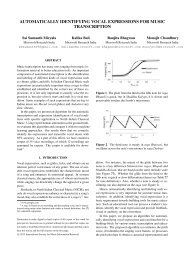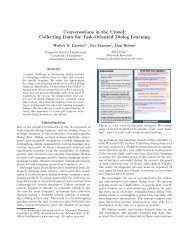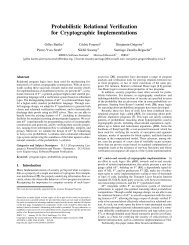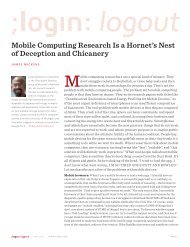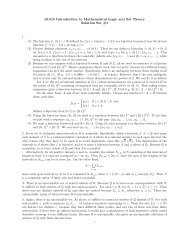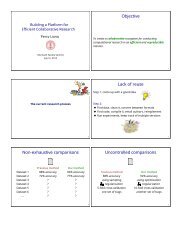Automatic Exposure Correction of Consumer Photographs
Automatic Exposure Correction of Consumer Photographs
Automatic Exposure Correction of Consumer Photographs
Create successful ePaper yourself
Turn your PDF publications into a flip-book with our unique Google optimized e-Paper software.
6 <strong>Automatic</strong> <strong>Exposure</strong> <strong>Correction</strong> <strong>of</strong> <strong>Consumer</strong> <strong>Photographs</strong><br />
the term “relative contrast” for this distance. For example, when their histograms are<br />
too close, we say their relative contrast is small.<br />
Zones estimation as an optimization. With the two measures defined, we formulate<br />
the best zone estimation as a graph-based labeling problem. Each zone region is regarded<br />
as a node and any two neighboring zone regions are connected by a link. The optimal<br />
labels Z = {z∗ i } <strong>of</strong> nodes are the final desired zones. We define the Markov Random<br />
Field (MRF) energy function E(Z) <strong>of</strong> the graph as:<br />
Z ∗ = arg min E(Z) = arg min<br />
Z Z (�<br />
i Ei + λ �<br />
i,j Eij),<br />
where Ei is the data term <strong>of</strong> an individual region i, and Eij is the pairwise term between<br />
two adjacent regions i and j. In our work, the data term and pairwise term are<br />
respectively specified by the form: Ei = −log(P (i)) and Eij = −log(P (i, j)).<br />
The likelihood P (i) <strong>of</strong> a region i is measured by its visibility <strong>of</strong> details νi, the<br />
region size Ci (normalized by the whole image size), and the important region size θi<br />
(normalized by the whole image size). The important region is directly computed from<br />
the probability map <strong>of</strong> facial/sky detector. We take into account all the three factors:<br />
�<br />
s νi × Ci × θi × ρ (ˆzi − zi) , (zi < V)<br />
P (i) =<br />
νh i × Ci<br />
, (2)<br />
× θi × ρ (zi − ˆzi) , (zi > V)<br />
where zi is the original zone, ˆzi is the new zone and ρ(t) = 1/ (1 + exp(−t)) is a<br />
sigmoid function. The likelihood would encourage shadow/highlight regions to move<br />
to higher/lower zones. For mid-zones (zone V), it takes no effect.<br />
The coherence P (i, j) is defined by the change <strong>of</strong> relative contrast between two<br />
neighboring regions, from the original relative contrast dij (before the optimization) to<br />
the new relative contrast ˆ dij (after the optimization), which is denoted by<br />
P (i, j) = Cj × G( ˆ dij − dij), (3)<br />
where G(·) is a zero-mean gaussian function with variance 0.15 and the weight Cj is<br />
used so that relatively smaller regions contribute less. The coherence would penalize<br />
the dramatic change <strong>of</strong> relative contrast.<br />
To obtain the global optimum, we use a brute-force searching method to travel all<br />
combinations <strong>of</strong> zone candidates for all regions because the total number <strong>of</strong> zone regions<br />
is not very high after region merging. To automatically estimate the weight λ, we<br />
first calculate the sum <strong>of</strong> data terms and the sum <strong>of</strong> pairwise terms across all combinations<br />
<strong>of</strong> zone candidates. Then we set λ to the ratio <strong>of</strong> two summations. We found it<br />
works very well in our experiments and does not require any tuning.<br />
5 Detail-preserving S-curve Adjustment<br />
After getting the optimal zone for every region, we might have mapped the zone value<br />
(i.e., exposure) <strong>of</strong> each region to its desired zone individually. However, this local<br />
mapping has the risk to produce exposure distortion in relatively small regions because<br />
these regions <strong>of</strong>ten contain insufficient information to estimate their optimal zones. To



